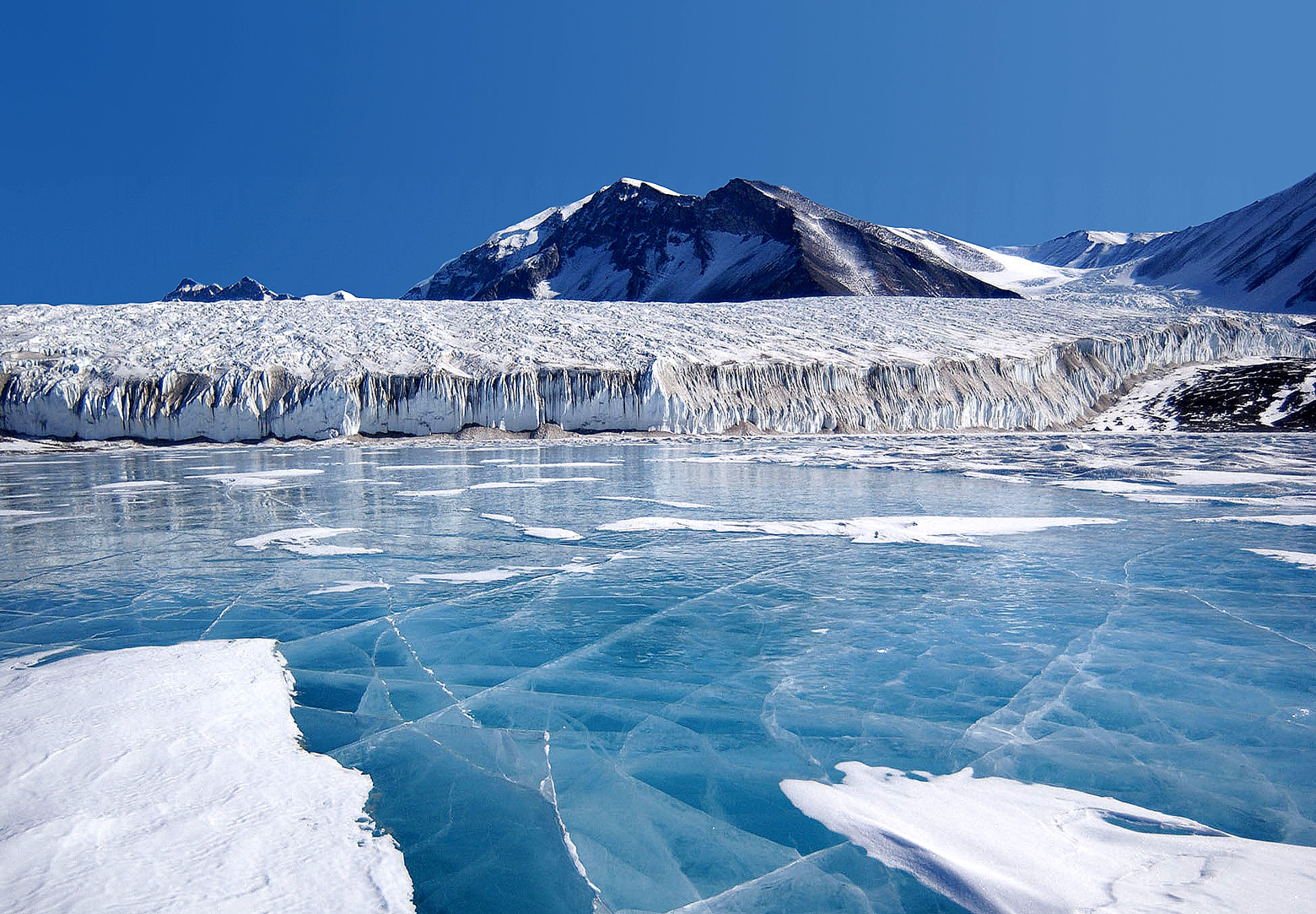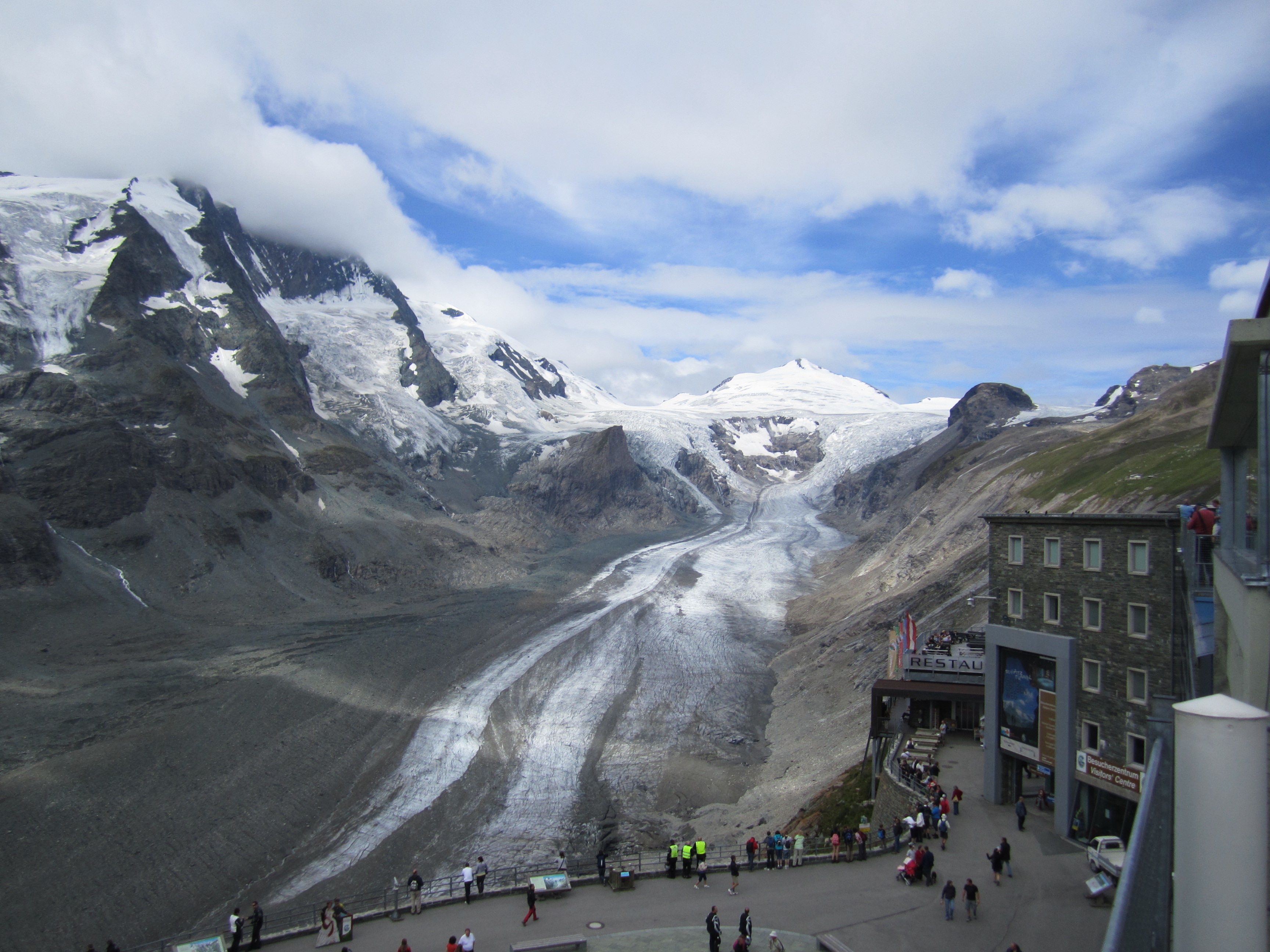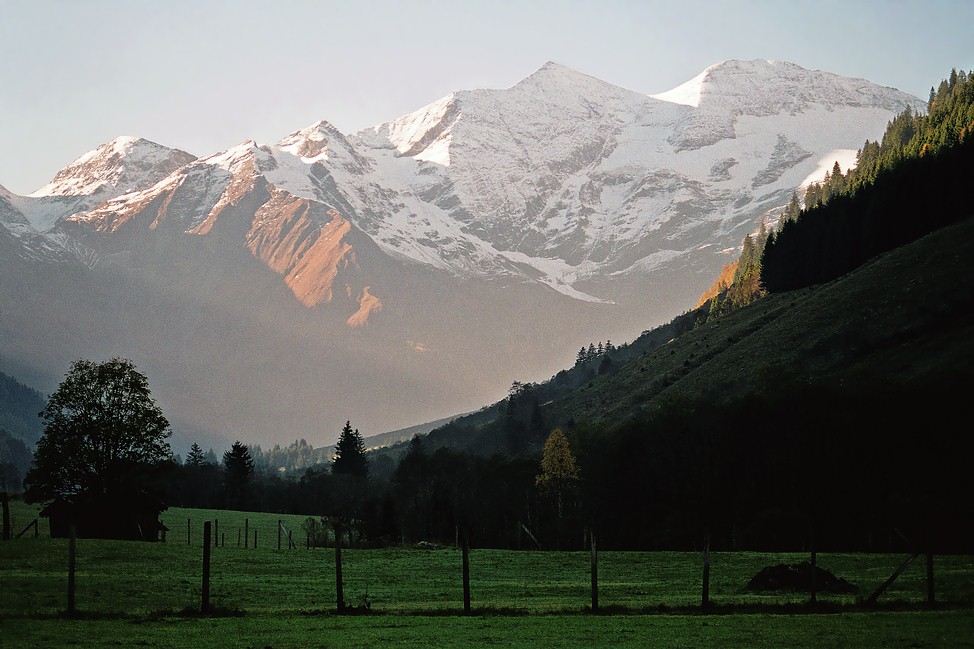|
Pasterze Glacier
The Pasterze, at approximately 8.4 kilometres (5.2 mi) in length, is the longest glacier in Austria and in the Eastern Alps. It lies within the Glockner Group of the High Tauern mountain range in Carinthia, directly beneath Austria's highest mountain, the Grossglockner. The length of the glacier is currently decreasing by about 50 m (160 ft) each year. Its volume has diminished by half since the first measurements in 1851. Geography The glacier reaches from its head, the Johannisberg peak at , to above sea level ( m AA). The Pasterze forms the source region of the Möll river, a left tributary of the Drava. Its waters also feed the Margaritze reservoir, used to generate electricity at the Kaprun hydropower plant north of the Alpine crest. The name ''Pasterze'' is possibly derived from sl, pasti, "pasture". Indeed the detection of wood, peat and pollen in the area of the retreating glacier indicate vegetation and also the use as pastureland during the la ... [...More Info...] [...Related Items...] OR: [Wikipedia] [Google] [Baidu] |
Grossglockner
The Grossglockner (german: Großglockner ; or just ''Glockner'') is, at 3,798 metres above the Adriatic (12,461 ft), the highest mountain in Austria and the highest mountain in the Alps east of the Brenner Pass. It is part of the larger Glockner Group of the Hohe Tauern range, situated along the main ridge of the Central Eastern Alps and the Alpine divide. The Pasterze, Austria's most extended glacier, lies on the Grossglockner's eastern slope. The characteristic pyramid-shaped peak actually consists of two pinnacles, the ''Grossglockner'' and the Kleinglockner (, from German: ''groß'', "big", ''klein'', "small"), separated by the ''Glocknerscharte'' col. Etymology The name ''Glocknerer'' is first documented in a 1561 map designed by the Viennese cartographer Wolfgang Lazius. The denotation ''Glogger'' is mentioned a 1583 description of the Tyrolean Kals legal district, then referring to the whole ridge south of the Alpine main chain. In the 1760s, the ''Atlas Tyro ... [...More Info...] [...Related Items...] OR: [Wikipedia] [Google] [Baidu] |
Kaprun
Kaprun () is a municipality in the Zell am See District in the state of Salzburg, Austria. The town is a tourist destination known as "Zell am See-Kaprun" with the neighbouring Zell am See and known for the glacier Kitzsteinhorn. Geography It is located in the Pinzgau region on the northern slopes of the Alpine Glockner Group with Mt. Großes Wiesbachhorn, , part of the Hohe Tauern range, forming the border of Salzburg with Carinthia. Located at the foot of the Kitzsteinhorn Glacier, Kaprun is a year-round sports centre. The Kapruner Ache creek joins the Salzach River south of the settlement. The Mooserboden hydroelectric plant uses water from two reservoirs held back by some of Austria's largest dam walls. The reservoir area has become a tourist attraction, with views over the towns of Kaprun and Zell am See. The visitors centre gives guided tours of the area. Tauern Spa World was completed in November 2010 and is the second largest spa complex in Austria. It is a two-hour transf ... [...More Info...] [...Related Items...] OR: [Wikipedia] [Google] [Baidu] |
Landforms Of Carinthia (state)
A landform is a natural or anthropogenic land feature on the solid surface of the Earth or other planetary body. Landforms together make up a given terrain, and their arrangement in the landscape is known as topography. Landforms include hills, mountains, canyons, and valleys, as well as shoreline features such as bays, peninsulas, and seas, including submerged features such as mid-ocean ridges, volcanoes, and the great ocean basins. Physical characteristics Landforms are categorized by characteristic physical attributes such as elevation, slope, orientation, stratification, rock exposure and soil type. Gross physical features or landforms include intuitive elements such as berms, mounds, hills, ridges, cliffs, valleys, rivers, peninsulas, volcanoes, and numerous other structural and size-scaled (e.g. ponds vs. lakes, hills vs. mountains) elements including various kinds of inland and oceanic waterbodies and sub-surface features. Mountains, hills, plateaux, and plains are t ... [...More Info...] [...Related Items...] OR: [Wikipedia] [Google] [Baidu] |
Glaciers Of Austria
A glacier ( ) or () is a persistent body of dense ice that is constantly moving under its own weight; it forms where the accumulation of snow exceeds its ablation (melting and sublimation) over many years, often centuries. Glaciers slowly deform and flow due to stresses induced by their weight, creating crevasses, seracs, and other distinguishing features. Because glacial mass is affected by long-term climate changes, e.g., precipitation, mean temperature, and cloud cover, glacial mass changes are considered among the most sensitive indicators of climate change. There are about 198,000 to 200,000 glaciers in the world. Glaciers by continent Africa Africa, specifically East Africa, has contained glacial regions, possibly as far back as the last glacier maximum 10 to 15 thousand years ago. Seasonal snow does exist on the highest peaks of East Africa as well as in the Drakensberg Range of South Africa, the Stormberg Mountains, and the Atlas Mountains in Morocco. Current ... [...More Info...] [...Related Items...] OR: [Wikipedia] [Google] [Baidu] |
Effects Of Global Warming
The effects of climate change impact the physical environment, ecosystems and human societies. The environmental effects of climate change are broad and far-reaching. They affect the water cycle, oceans, sea and land ice (glaciers), sea level, as well as weather and climate extreme events. The changes in climate are not uniform across the Earth. In particular, most land areas have warmed faster than most ocean areas, and the Arctic is warming faster than most other regions. The regional changes vary: at high latitudes it is the average temperature that is increasing, while for the oceans and tropics it is in particular the rainfall and the water cycle where changes are observed. The magnitude of future impacts of climate change can be reduced by climate change mitigation and adaptation. Climate change has degraded land by raising temperatures, drying soils and increasing wildfire risk. Recent warming has strongly affected natural biological systems. Species worldwide are ... [...More Info...] [...Related Items...] OR: [Wikipedia] [Google] [Baidu] |
Retreat Of Glaciers Since 1850
The retreat of glaciers since 1850 affects the availability of fresh water for irrigation and domestic use, mountain recreation, animals and plants that depend on glacier-melt, and, in the longer term, the level of the oceans. Deglaciation occurs naturally at the end of ice ages, but glaciologists find the current glacier retreat is accelerated by the measured increase of atmospheric greenhouse gases—an effect of climate change. Mid-latitude mountain ranges such as the Himalayas, Rockies, Alps, Cascades, Southern Alps, and the southern Andes, as well as isolated tropical summits such as Mount Kilimanjaro in Africa, are showing some of the largest proportionate glacial losses. Excluding peripheral glaciers of ice sheets, the total cumulated global glacial losses over the 26 year period from 1993–2018 were likely 5500 gigatons, or 210 gigatons per yr.Fox-Kemper, B., H.T. Hewitt, C. Xiao, G. Aðalgeirsdóttir, S.S. Drijfhout, T.L. Edwards, N.R. Golledge, M. Hemer, R.E. Kopp, ... [...More Info...] [...Related Items...] OR: [Wikipedia] [Google] [Baidu] |
List Of Glaciers
A glacier ( ) or () is a persistent body of dense ice that is constantly moving under its own weight; it forms where the accumulation of snow exceeds its ablation (melting and sublimation) over many years, often centuries. Glaciers slowly deform and flow due to stresses induced by their weight, creating crevasses, seracs, and other distinguishing features. Because glacial mass is affected by long-term climate changes, e.g., precipitation, mean temperature, and cloud cover, glacial mass changes are considered among the most sensitive indicators of climate change. There are about 198,000 to 200,000 glaciers in the world. Glaciers by continent Africa Africa, specifically East Africa, has contained glacial regions, possibly as far back as the last glacier maximum 10 to 15 thousand years ago. Seasonal snow does exist on the highest peaks of East Africa as well as in the Drakensberg Range of South Africa, the Stormberg Mountains, and the Atlas Mountains in Morocco. Current ... [...More Info...] [...Related Items...] OR: [Wikipedia] [Google] [Baidu] |
Grossglockner High Alpine Road
The Grossglockner High Alpine Road (in German ''Großglockner Hochalpenstraße'') is the highest surfaced mountain pass road in Austria. It connects Bruck an der Großglocknerstraße, Bruck in the state of Salzburg (state), Salzburg with Heiligenblut in Carinthia (state), Carinthia via Fuscher Törl at 2,428 m (7,966 ft) and Hochtor Pass at . The road is named after the Grossglockner, Austria's highest mountain. Built as a scenic route, a toll road, toll is assessed for passage. Course The road leads from Bruck in the Salzach Valley via the northern toll booth at Ferleiten (near Fusch an der Großglocknerstraße, Fusch) with numbered hairpin curves up to Hochtor Pass, with a branch-off from Fuscher Törl at to the ''Edelweißspitze'' viewpoint at 2,571 m (8,435 ft). The scenic route crosses the Main chain of the Alps, Alpine divide in a tunnel and runs southwards passing another branch-off which leads to the ''Glocknerhaus'' mountain hut and the Kaiser-Franz-Josefs-Höhe visi ... [...More Info...] [...Related Items...] OR: [Wikipedia] [Google] [Baidu] |
National Parks Of Austria
Austria has six national parks, all of them internationally accepted according to the IUCN standard. The first national park, Hohe Tauern, was established in 1981. They include each of Austria's most important natural landscape types — alluvial forest, Alpine massif, Pannonian steppe and rocky valleys. Development First plans for the protection of the Hohe Tauern mountain range were evolved by Austrian Alpine Club, which in 1915-18 acquired large mountainous areas. However, the national park project was abandoned in the late 1930s and not resumed until 1971, when the federal states of Salzburg, Tyrol and Carinthia signed the Heiligenblut Agreement, followed by similar initiatives in Lower and Upper Austria. The establishment of each national park took several years; as conflicts of use and the question of funding had to be resolved. The parks are managed by contracts between one or more of the federal states and the Federal Government, with the financing shared equally ... [...More Info...] [...Related Items...] OR: [Wikipedia] [Google] [Baidu] |
German And Austrian Alpine Club
The German and Austrian Alpine Club (german: Deutscher und Österreichischer Alpenverein, DuÖAV) was a merger of the German, Austrian and German Bohemian Alpine Club that existed from 1873 to 1938. History In 1862 the ''Sektion Austria'' was founded in Vienna by the academics Paul Grohmann, Friedrich Simony and Edmund von Mojsisovics. It was the first mountaineering club on the continent, modelled on the London Alpine Club. About seven years later, the Austrian mountaineer Franz Senn founded the '' Bildungsbürgerlicher Bergsteigerverein'' in Munich. Both organisations merged in 1873 to form the German and Austrian Alpine Club. The main organisation consisted of numerous legally independent sections responsible for the upkeep of Alpine club huts and footpaths. In 1918 the DuÖAV purchased about of land at the Pasterze Glacier of the Grossglockner massif, which became the nucleus of the present-day High Tauern National Park. From the mid 1920s the club placed an increased focus ... [...More Info...] [...Related Items...] OR: [Wikipedia] [Google] [Baidu] |
Interglacial
An interglacial period (or alternatively interglacial, interglaciation) is a geological interval of warmer global average temperature lasting thousands of years that separates consecutive glacial periods within an ice age. The current Holocene interglacial began at the end of the Pleistocene, about 11,700 years ago. Pleistocene During the 2.5 million years of the Pleistocene, numerous glacials, or significant advances of continental ice sheets, in North America and Europe, occurred at intervals of approximately 40,000 to 100,000 years. The long glacial periods were separated by more temperate and shorter interglacials. During interglacials, such as the present one, the climate warms and the tundra recedes polewards following the ice sheets. Forests return to areas that once supported tundra vegetation. Interglacials are identified on land or in shallow epicontinental seas by their paleontology. Floral and faunal remains of species pointing to temperate climate and indicating a ... [...More Info...] [...Related Items...] OR: [Wikipedia] [Google] [Baidu] |
Main Chain Of The Alps
The main chain of the Alps, also called the Alpine divide is the central line of mountains that forms the drainage divide of the range. Main chains of mountain ranges are traditionally designated in this way, and generally include the highest peaks of a range. The Alps are something of an unusual case in that several significant groups of mountains are separated from the main chain by sizable distances. Among these groups are the Dauphine Alps, the Eastern and Western Graians, the entire Bernese Alps, the Tödi, Albula and Silvretta groups, the Ortler and Adamello ranges, and the Dolomites of South Tyrol, as well as the lower Alps of Vorarlberg, Bavaria, and Salzburg. Main features The Alpine Divide is defined for much of its distance by the watershed between the drainage basin of the Po in Italy on one side, with the other side of the divide being formed by the Rhone, the Rhine and the Danube. Further east, the watershed is between the Adige and the Danube, before headin ... [...More Info...] [...Related Items...] OR: [Wikipedia] [Google] [Baidu] |

.png)

.jpg)






